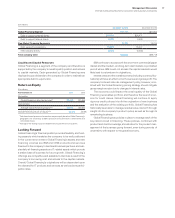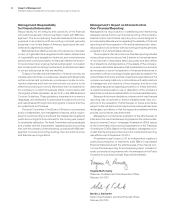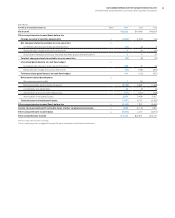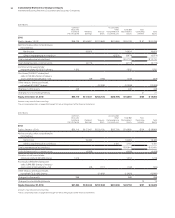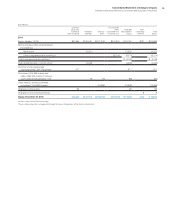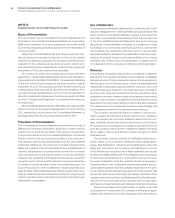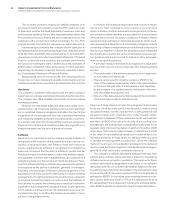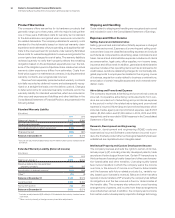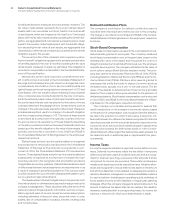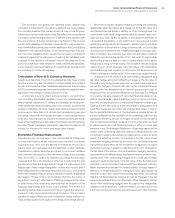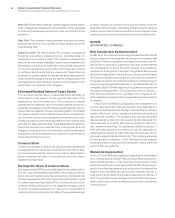IBM 2014 Annual Report Download - page 87
Download and view the complete annual report
Please find page 87 of the 2014 IBM annual report below. You can navigate through the pages in the report by either clicking on the pages listed below, or by using the keyword search tool below to find specific information within the annual report.Notes to Consolidated Financial Statements
International Business Machines Corporation and Subsidiary Companies
86
NOTE A.
SIGNIFICANT ACCOUNTING POLICIES
Basis of Presentation
The accompanying Consolidated Financial Statements and
footnotes of the International Business Machines Corporation
(IBM or the company) have been prepared in accordance with
accounting principles generally accepted in the United States of
America (GAAP).
Within the financial statements and tables presented, cer-
tain columns and rows may not add due to the use of rounded
numbers for disclosure purposes. Percentages presented are cal-
culated from the underlying whole-dollar amounts. Certain prior
year amounts have been reclassified to conform to the current year
presentation. This is annotated where applicable.
On October20, 2014, the company announced a definitive
agreement to divest its Microelectronics business and manufactur
-
ing operations to GLOBALFOUNDRIES. The assets and liabilities
of the Microelectronics business are reported as held for sale at
December31, 2014. The operating results of the Microelectronics
business have been reported as discontinued operations. Prior
periods have been reclassified to conform to this presentation to
allow for a meaningful comparison of continuing operations. Refer
to noteC, “Acquisitions/Divestitures,” for additional information on
the transaction.
Noncontrolling interest amounts of $6 million, $7 million and $11
million, net of tax, for the years ended December31, 2014, 2013 and
2012, respectively, are included in the Consolidated Statement of
Earnings within the other (income) and expense line item.
Principles of Consolidation
The Consolidated Financial Statements include the accounts of
IBM and its controlled subsidiaries, which are primarily majority
owned. Any noncontrolling interest in the equity of a subsidiary
is reported in Equity in the Consolidated Statement of Financial
Position. Net income and losses attributable to the noncontrol-
ling interest is reported as described above in the Consolidated
Statement of Earnings. The accounts of variable interest entities
(VIEs) are included in the Consolidated Financial Statements, if
required. Investments in business entities in which the company
does not have control, but has the ability to exercise significant
influence over operating and financial policies, are accounted for
using the equity method and the company’s proportionate share
of income or loss is recorded in other (income) and expense. The
accounting policy for other investments in equity securities is on
page 95 within “Marketable Securities.” Equity investments in non-
publicly traded entities are primarily accounted for using the cost
method. All intercompany transactions and accounts have been
eliminated in consolidation.
Use of Estimates
The preparation of financial statements in conformity with GAAP
requires management to make estimates and assumptions that
affect the amounts of assets, liabilities, revenue, costs, expenses
and other comprehensive income/(loss) (OCI) that are reported
in the Consolidated Financial Statements and accompanying
disclosures. These estimates are based on management’s best
knowledge of current events, historical experience, actions that
the company may undertake in the future and on various other
assumptions that are believed to be reasonable under the circum
-
stances. As a result, actual results may be different from these
estimates. See “Critical Accounting Estimates” on pages 68 to 71
for a discussion of the company’s critical accounting estimates.
Revenue
The company recognizes revenue when it is realized or realizable
and earned. The company considers revenue realized or realizable
and earned when it has persuasive evidence of an arrangement,
delivery has occurred, the sales price is fixed or determinable and
collectibility is reasonably assured. Delivery does not occur until
products have been shipped or services have been provided to
the client, risk of loss has transferred to the client, and either client
acceptance has been obtained, client acceptance provisions have
lapsed, or the company has objective evidence that the criteria
specified in the client acceptance provisions have been satisfied.
The sales price is not considered to be fixed or determinable until
all contingencies related to the sale have been resolved.
The company recognizes revenue on sales to solution pro-
viders, resellers and distributors (herein referred to as “resellers”)
when the reseller has: economic substance apart from the com-
pany, credit risk, title and risk of loss to the inventory; and, the fee to
the company is not contingent upon resale or payment by the end
user, the company has no further obligations related to bringing
about resale or delivery and all other revenue recognition criteria
have been met.
The company reduces revenue for estimated client returns,
stock rotation, price protection, rebates and other similar allow
-
ances. (See Schedule II, “Valuation and Qualifying Accounts and
Reserves” included in the company’s Annual Report on Form
10-K). Revenue is recognized only if these estimates can be rea-
sonably and reliably determined. The company bases its estimates
on historical results taking into consideration the type of client,
the type of transaction and the specifics of each arrangement.
Payments made under cooperative marketing programs are rec-
ognized as an expense only if the company receives from the client
an identifiable benefit sufficiently separable from the product sale
whose fair value can be reasonably and reliably estimated. If the
company does not receive an identifiable benefit sufficiently sepa-
rable from the product sale whose fair value can be reasonably
estimated, such payments are recorded as a reduction of revenue.
Revenue from sales of third-party vendor products or services
is recorded net of costs when the company is acting as an agent
between the client and the vendor, and gross when the company



